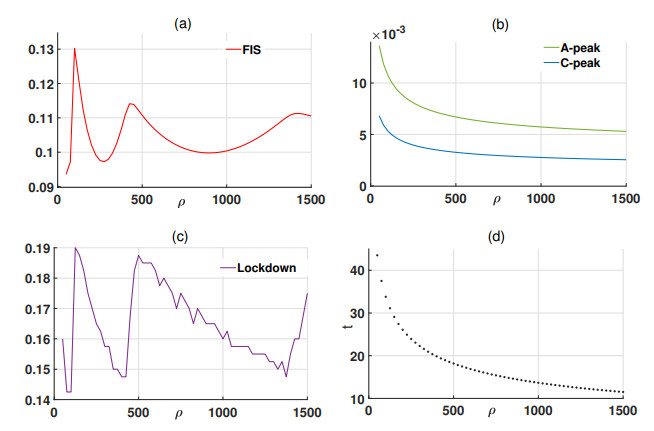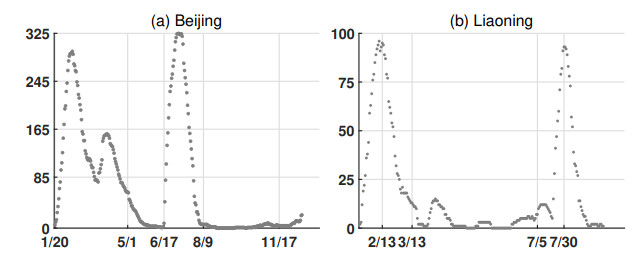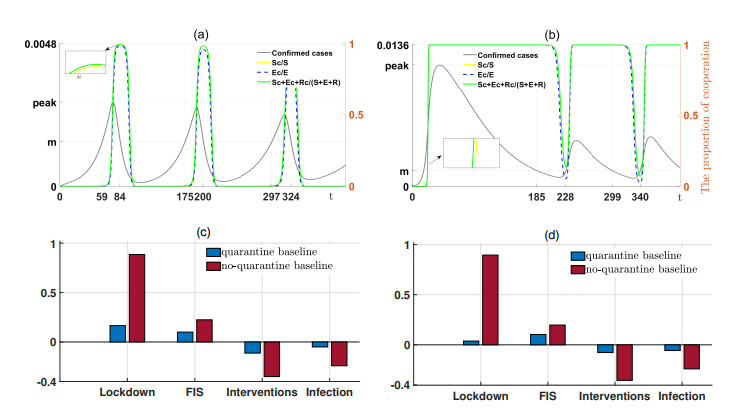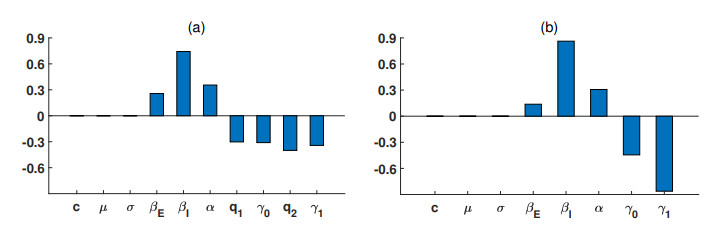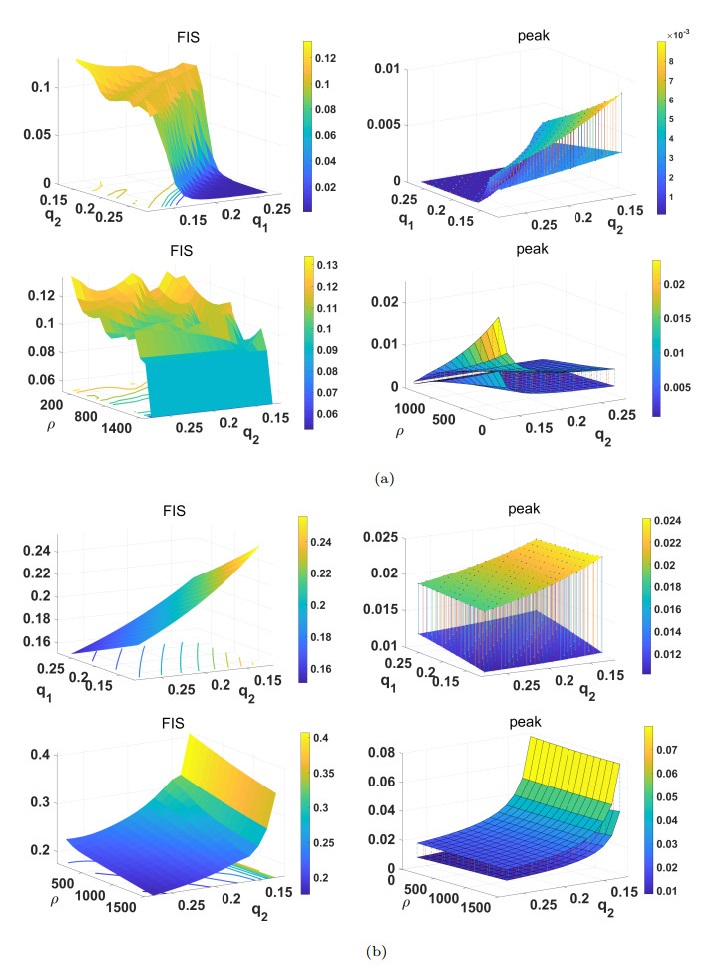| Citation: | Susu Jia, Xinzhu Meng, Tonghua Zhang. THE EFFECTIVENESS OF HUMAN INTERVENTIONS AGAINST COVID-19 BASED ON EVOLUTIONARY GAME THEORY[J]. Journal of Applied Analysis & Computation, 2022, 12(5): 1748-1762. doi: 10.11948/20210269 |
THE EFFECTIVENESS OF HUMAN INTERVENTIONS AGAINST COVID-19 BASED ON EVOLUTIONARY GAME THEORY
-
Abstract
Social distancing strategy (including Six-Foot Rule, wearing masks, and other easy-to-operate measures) and quarantine measures have played a critical role in the early stage of the COVID-19 epidemic. In order to explore the mechanisms of these two human interventions accurately, we develop a coupling epidemiological-behavioral model based on evolutionary game theory. Individuals decide whether to take strategy measures based on rational consideration of payoffs. Moreover, authorities also balance the costs and effectiveness of the interventions at the public level. Our simulation shows that social distancing strategy can suppress every single outbreak effectively. In the early stage of an epidemic, the implementation of the quarantine measures determines the scale of the epidemic. Timely and effective quarantine measures can control recurrent outbreaks without social lockdown. Support policy for individual-level intervention or high diagnosis rates are beneficial to control the epidemic but require long-term social lockdown.
-
Keywords:
- COVID-19 /
- mathematical epidemiology /
- imitation dynamics /
- quarantine /
- social distancing
-

-
References
[1] M. A. Amaral, M. M. de Oliveira and M. A. Javarone, An epidemiological model with voluntary quarantine strategies governed by evolutionary game dynamics, arXiv[physics. soc-ph], 2020, 13–15. [2] C. T. Bauch, Imitation dynamics predict vaccinating behaviour, Proc. Biol. Sci., 2005, 272(1573), 1669–1675. [3] S. Bhattacharyya and T. Reluga, Game dynamic model of social distancing while cost of infection varies with epidemic burden, IMA Journal of Applied Mathematics, 2019, 84(1), 23–43. doi: 10.1093/imamat/hxy047 [4] B. Boulfoul, A. Kerboua and X. Zhou, Mathematical modeling and analysis of an epidemic model with quarantine, latent and media coverage, Journal of Nonlinear Modeling and Analysis, 2022, 4(1), 43–63. [5] G. Cacciapaglia, C. Cot and F. Sannino, Second wave Covid-19 pandemics in europe: a temporal playbook, Sci. Rep., 2020, 10(1), 15514. doi: 10.1038/s41598-020-72611-5 [6] S. Chang, M. Piraveenan, P. Pattison et al., Game theoretic modelling of infectious disease dynamics and intervention methods: a review, J. Biol. Dyn., 2020, 14(1), 57–89. doi: 10.1080/17513758.2020.1720322 [7] S. Del Valle, H. Hethcote, J. M. Hyman et al., Effects of behavioral changes in a smallpox attack model, Math. Biosci., 2005, 195(2), 228–51. doi: 10.1016/j.mbs.2005.03.006 [8] E. Dong, H. Du and L. Gardner, An interactive web-based dashboard to track Covid-19 in real time, Lancet. Infect. Dis., 2020, 20(5), 533–534. doi: 10.1016/S1473-3099(20)30120-1 [9] S. Funk, E. Gilad, C. Watkins et al., The spread of awareness and its impact on epidemic outbreaks, Proc. Natl. Acad. Sci., 2009, 106(16), 6872–6877. doi: 10.1073/pnas.0810762106 [10] L. P. Garcia and E. Duarte, Nonpharmaceutical interventions for tackling the Covid-19 epidemic in Brazil, Epidemiol. Serv. Saude., 2020, 29(2), e2020222. [11] S. Hanaei and N. Rezaei, Covid-19: Developing from an outbreak to a pandemic, Arch. Med. Res., 2020, 51(6), 582–584. doi: 10.1016/j.arcmed.2020.04.021 [12] J. Hellewell, S. Abbott, A. Gimma et al., Feasibility of controlling Covid-19 outbreaks by isolation of cases and contacts, Lancet. Glob. Health., 2020, 8(4), e488–e496. doi: 10.1016/S2214-109X(20)30074-7 [13] K. M. A. Kabir and J. Tanimoto, Evolutionary game theory modelling to represent the behavioural dynamics of economic shutdowns and shield immunity in the Covid-19 pandemic, R. Soc. Open. Sci., 2020, 7(9), 201095. doi: 10.1098/rsos.201095 [14] A. K. Kaliya-Perumal, J. Kharlukhi and U. F. Omar, The second wave of Covid-19: time to think of strategic stockpiles, Can. J. Public. Health., 2020, 111(4), 486–487. doi: 10.17269/s41997-020-00371-w [15] I. Z. Kiss, J. Cassell, M. Recker et al., The impact of information transmission on epidemic outbreaks, Math. Biosci., 2010, 225(1), 1–10. doi: 10.1016/j.mbs.2009.11.009 [16] M. U. G. Kraemer, C. Yang, B. Gutierrez et al., The effect of human mobility and control measures on the Covid-19 epidemic in China, Science, 2020, 368(6490), 493–497. doi: 10.1126/science.abb4218 [17] C. Lei and X. Han, Regional prediction of Covid-19 in the United States based on the difference equation model, Journal of Nonlinear Modeling and Analysis, 2021, 3(4), 547–559. [18] Q. Li, X. Guan, P. Wu et al., Early transmission dynamics in Wuhan, China, of novel coronavirus-infected pneumonia, N. Engl. J. Med., 2020, 382(13), 1199–1207. doi: 10.1056/NEJMoa2001316 [19] W. Li, J. Zhou and J. Lu, The effect of behavior of wearing masks on epidemic dynamics, Nonlinear Dyn., 2020, 101(3), 1–7. [20] Y. Li, R. Zhang, J. Zhao et al., Understanding transmission and intervention for the Covid-19 pandemic in the United States, Sci. Total. Environ., 2020, 748, 141560. doi: 10.1016/j.scitotenv.2020.141560 [21] Y. Liu, A. A. Gayle, A. Wilder-Smith et al., The reproductive number of Covid-19 is higher compared to SARS coronavirus, J. Travel Med., 2020, 27(2), 1–4. [22] Z. Liu, P. Magal, O. Seydi et al., A covid-19 epidemic model with latency period, Infect. Dis. Model, 2020, 5(11811530272), 323–337. [23] International Monetary Fund, World Economic Outlook: A Long and Difficult Ascent, Report 9781513556055, International Monetary Fund, 2020. [24] M. G. Mazza, R. De Lorenzo, C. Conte et al., Anxiety and depression in Covid-19 survivors: Role of inflammatory and clinical predictors, Brain Behav. Immun., 2020, 89, 594–600. doi: 10.1016/j.bbi.2020.07.037 [25] K. Meier, T. Glatz, M. C. Guijt et al., Public perspectives on protective measures during the Covid-19 pandemic in the Netherlands, Germany and Italy: A survey study, PLoS One, 2020, 15(8), e0236917. doi: 10.1371/journal.pone.0236917 [26] E. Otte Im Kampe, A. S. Lehfeld, S. Buda et al., Surveillance of Covid-19 school outbreaks, Germany, march to August 2020, Euro. Surveill, 2020, 25(38), 2001645–2001645. [27] P. Poletti, M. Ajelli and S. Merler, The effect of risk perception on the 2009 h1n1 pandemic influenza dynamics, PLoS One, 2011, 6(2), e16460. doi: 10.1371/journal.pone.0016460 [28] P. Poletti, M. Ajelli and S. Merler, Risk perception and effectiveness of uncoordinated behavioral responses in an emerging epidemic, Math. Biosci., 2012, 238(2), 80–89. doi: 10.1016/j.mbs.2012.04.003 [29] P. Poletti, B. Caprile, M. Ajelli et al., Spontaneous behavioural changes in response to epidemics, J. Theor. Biol., 2009, 260(1), 31–40. doi: 10.1016/j.jtbi.2009.04.029 [30] N. Salari, A. Hosseinian-Far, R. Jalali et al., Prevalence of stress, anxiety, depression among the general population during the Covid-19 pandemic: a systematic review and meta-analysis, Global Health, 2020, 16(1), 57. doi: 10.1186/s12992-020-00589-w [31] P. van den Driessche and J. Watmough, Reproduction numbers and sub-threshold endemic equilibria for compartmental models of disease transmission, Math. Biosci., 2002, 180(1-2), 29–48. doi: 10.1016/S0025-5564(02)00108-6 [32] G. Wallentin, D. Kaziyeva and E. Reibersdorfer-Adelsberger, Covid-19 intervention scenarios for a long-term disease management, Int. J. Health Policy Manag, 2020, 9(12), 508–516. [33] C. Xu, Z. Zhang, X. Huang et al., The dynamic effects of different quarantine measures on the spread of Covid-19, Journal of Applied Analysis and Computation, 2022, 1–1. [34] Z. Yang, Z. Zeng, K. Wang et al., Modified seir and ai prediction of the epidemics trend of Covid-19 in China under public health interventions, J. Thorac. Dis., 2020, 12(3), 165–174. doi: 10.21037/jtd.2020.02.64 [35] N. Zhang, P. Cheng, W. Jia et al., Impact of intervention methods on Covid-19 transmission in Shenzhen, Build. Environ., 2020, 180, 107106. doi: 10.1016/j.buildenv.2020.107106 [36] R. Zhang, Y. Li, L. Zhang et al., Identifying airborne transmission as the dominant route for the spread of Covid-19, Proceedings of the National Academy of Sciences, 2020, 117(26), 14857–14863. doi: 10.1073/pnas.2009637117 -
-
- Figure 1. The epidemic flow between epidemiological classes (represented by solid black lines) and imitation flow between strategy classes (represented by gray dotted lines).
-
Figure 2. Imitation speed
$ \rho $ sequence plots of each index. (a) The value of FIS with imitation speed axis$ \rho $ . (b) The value of A-peak and C-peak with imitation speed axis$ \rho $ . (c). The value of Lockdown with imitation speed axis$ \rho $ . (d). The scatter of delay with imitation speed axis$ \rho $ . - Figure 3. The time series plots of COVID-19 confirmed cases in Beijing and Liaoning province.
- Figure 4. Comparative simulation of quarantine measures. (a) The baseline scenario with quarantine. (b) The baseline scenario without quarantine. (c) Bar comparison chart of baseline scenario indicators on quarantine measures. (d). Bar comparison of indicators on quarantine measures at a higher diagnosis rate.
-
Figure 5. The sensitivity analysis of
$ R_0 $ in baseline scenarios. (a) The sensitivity analysis of the scenario with quarantine measures. (b) The sensitivity analysis of the scenario without quarantine measures. - Figure 6. Percentage of changes of epidemic prevention indicators of support policy. (a) The effectiveness of support policy. (b) The comparison between quarantine and support policies quarantine. Percentage of changes in epidemic prevention indies of support policy.
-
Figure 7. Simulation of interaction between two levels of human interventions. (a) The FIS and two peaks in the scenario with quarantine measures. (b) The FIS and the two peak values in the scenario without quarantine measures.
$ q_1\in(0.13,0.27) $ ,$ q_2\in(0.13,0.27) $ and$ \rho\in(50,1500) $ , and other parameters of the baseline scenario are reported in Table 1.



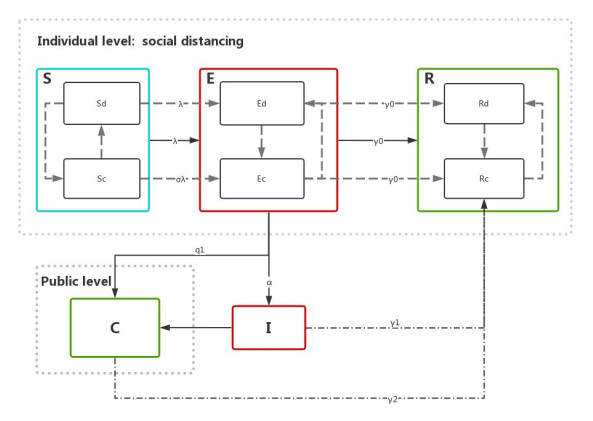

 DownLoad:
DownLoad:
